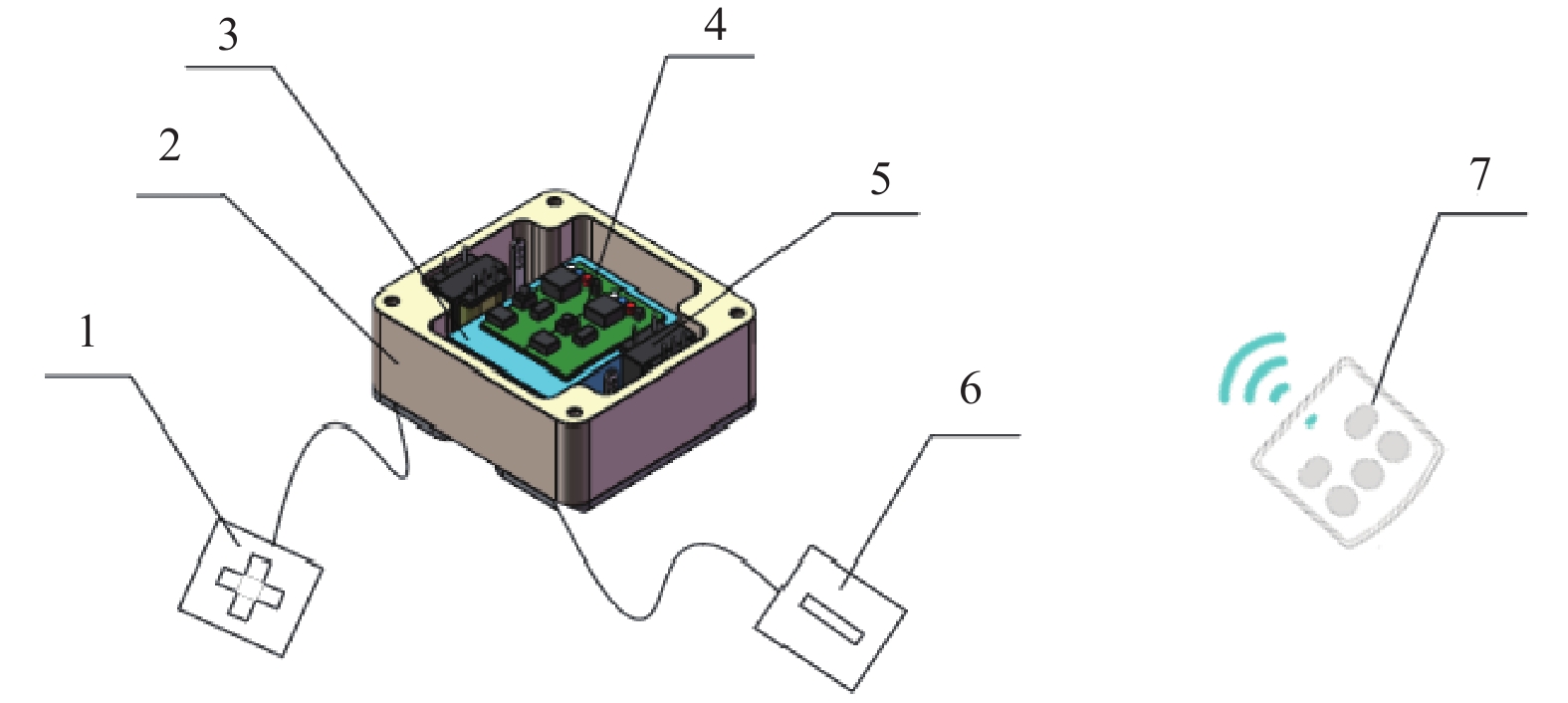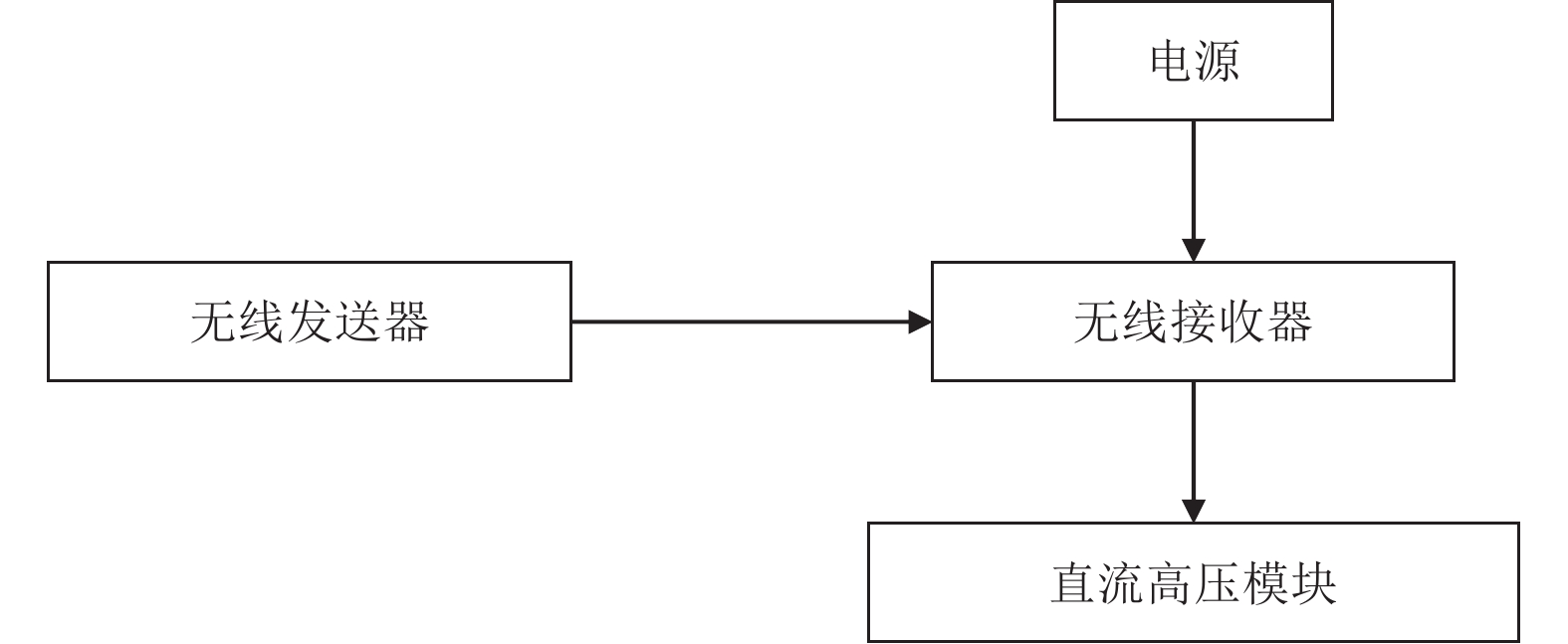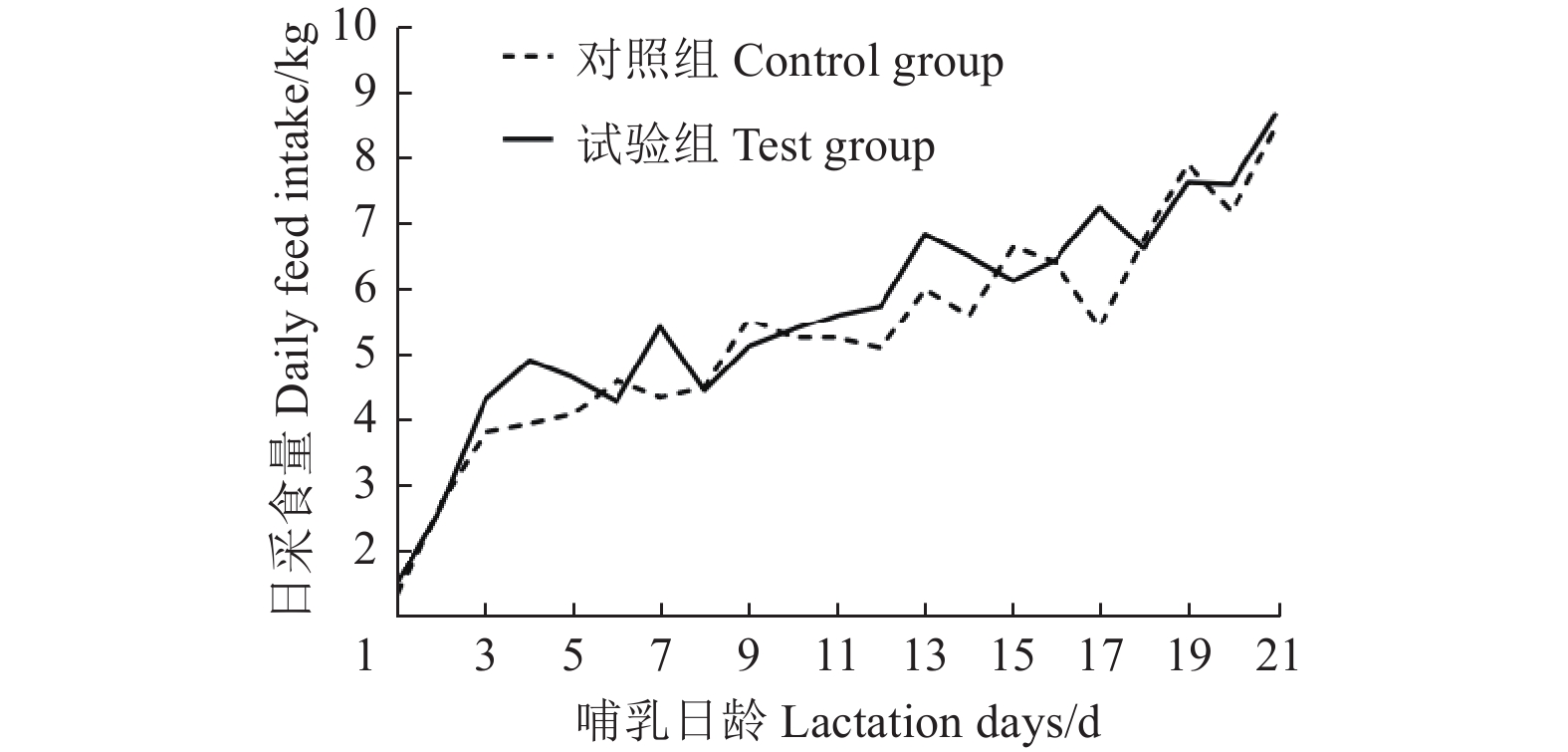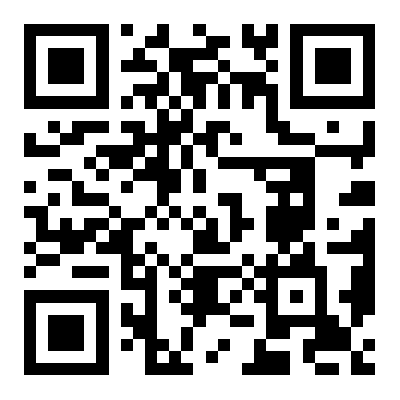Effects of electrical stimulation on the behavior and production performance of postpartum sows
-
摘要:
解救被压哺乳仔猪是提高规模化养殖场生产效益的重要手段,其中电刺激是最新技术之一,为优化目前电刺激技术研究参数单一,母猪过度反应等问题,该研究基于反应有效性和惊吓指数两类参数分析了产后母猪不同身体部位在不同刺激电压下的反应,确定了电刺激技术参数适宜值,并验证了该参数对母猪生产性能的影响。结果表明:电刺激装置通电0.5 s后,母猪在刺激电压
2000 和2400 V下的有效反应率皆为75%以上,且这2种刺激电压下发生有效反应的概率极显著高于1200 V(P<0.01)。母猪腰部的有效反应率为70.8%,该部位发生有效反应的概率比侧腹部和大腿根部高将近3倍左右。当刺激部位为腰部,刺激电压为2400 V时,母猪惊吓指数上限高于60%;当刺激部位为腰部,刺激电压2000 V时,惊吓指数上限低于60%,综合有效反应和惊吓指数结果,建议电刺激适宜参数为:电压2000 V,刺激部位为腰部。生产试验结果表明:在整个哺乳期,执行电刺激适宜参数的试验组母猪的平均日采食量(5.50 kg)和断奶窝质量(58.91 kg)略高于对照组的日采食量(5.45 kg)和断奶窝质量(58.42 kg),但两者差异不显著(P>0.05),由此可见,适宜电刺激参数对母猪实际生产性能没有影响。研究结果可为解救仔猪的设备研发与应用提供参考与数据支撑。Abstract:Electrical stimulation has emerged as a promising technique to save crushed piglets. But only the individual parameter of electrical stimulation was considered in the excessive response of sows. In this study, a systematic investigation was conducted to determine the response of the effectiveness and startle index of sows under different body positions and stimulated voltages. An evaluation was made to clarify the electrical stimulation on the production performance of sows. The field experiment was conducted at a farrowing house in Shandong Province, China, between November and December of 2022. A total of 72 healthy first-born sows were selected and then randomly assigned to 12 treatment groups, with six sows in each group. The waist, flank, and thigh root were selected as the stimulated positions. Electrical stimulation was applied at voltages of
1200 ,1600 ,2000 , and2400 V, resulting in a total of 12 treatments. The hair was removed from the stimulated positions of all experimental sows, in order to ensure that the positive and negative electrodes of the electrical stimulation device were in close contact with the pig's skin. An electrical stimulation was administered, when the sow side lying. Their body behaviors (lie, sit, stand, and jump) and sounds (silent, grunt, bark, squeal, and bite) were synchronously recorded by a mobile phone camera. An optimal combination was determined for the most appropriate electrical stimulated position and stimulated voltage. The feed intake and growth rate of piglets were measured to verify the impact of appropriate electrical stimulation on the production performance of sows. Two treatment groups of five sows were randomly assigned to the total of 10 healthy first-born sows with a minimum of 12 functional nipples. The newborn piglets were fostered within the first 24 hours after birth. There was no significant difference in the litter weights (P>0.05). Furthermore, the electrical stimulation was applied daily on each lying sow between 08:00-17:00 in the treatment group within the first three days post-partum. There was no intervention in the control group. All sows were fed three times per day from day 8 to 21 of the lactation (weaning age). The results demonstrate that the effective response rate and the startle index of the test sows showed an upward trend, as the voltage increased. The effective response rate of the test sows was below 50% at stimulated voltages of1200 and1600 V. However, the effective response rate exceeded 75% in2000 and2400 V. Compared with the voltage of 1 200 V, the probability of effective response of the sows under these voltages (2000 and2400 V) increased by about 21.645 and 52.366 times, respectively, which was extremely significant (P<0.01). The effective response rate of the waist was 70.8% for the stimulated positions, which was higher than the flank and thigh root by 20.8%. The probability of effective response of the waist was nearly 3 times higher than the flank. Lower voltage was negligible to stimulate the standing response of sows. But, the maximum startle index of the sows exceeded 60% at a stimulated voltage of2400 V. It inferred that the risk of stress reactions of saws increased their production performance. The maximum startle index was lower than 60% at2000 V. Therefore, electrical stimulation of2000 V can be recommended to place the electrical stimulation device on the waist, according to the effective response and startle index. The production experiment demonstrated that the feed intake per day (5.50 kg) and weaning litter weight (58.91 kg) of the experimental group under the appropriate electrical stimulation parameters were slightly higher than the control group, which were the average daily feed intake (5.45 kg) and weaning litter weight (58.42 kg). But the differences were not significant (P>0.05). The appropriate parameters (2000 V, waist) had no statistically significant effect on the reproductive performance of sows. These findings can provide valuable reference and data support for the development and application of equipment to rescue piglets.-
Keywords:
- sows /
- voltage /
- production performance /
- crushed piglets /
- electrical stimulation /
- sow behavior
-
0. 引 言
仔猪断奶前死亡是关乎生猪生产的一个重要的经济和动物福利问题。目前中国仔猪死亡数占活产仔数的15%~20%,仔猪断奶前死亡率居高不下是制约中国养猪产能发展的主要瓶颈之一 [1-3]。据统计,在哺乳期死亡的仔猪中,因被母猪挤压致死的仔猪通常占死亡总数的 20%~50%,最高可达80%[4-5]。
仔猪被压通常发生在母猪从直立到平躺、从胸骨卧位到横向卧位以及在滚动运动过程中[6]。目前国内通用的技术是采用分娩限位栏,通过合理设置栏位及防压杆的尺寸大小来限制母猪快速且大幅度的危险活动,给仔猪较长反应逃跑时间,以降低仔猪被压的概率[7]。但由于母猪在限位栏内不能转身,躺卧或行为转换时难以充分观察仔猪位置,导致仔猪被压及被踩情况仍存在[8-9]。
解救仔猪的最新方法是通过视觉或声音识别技术来判断仔猪可能被压的情况[10-13],而后执行机构干预母猪的活动,改变母猪的姿势,进而解救被压仔猪[14]。因此解救被压仔猪的技术主要包括:仔猪被压识别和解救执行。目前,国外科研人员对解救执行技术进行了诸多研究,ELEVOTECK公司设计了防压升降产床,实现潜在危险情况下母猪与仔猪在空间上的分离,从而预防仔猪被压,但因改造复杂、成本高等原因阻碍了其在猪场的推广应用[15-16];JEON等[17]根据仔猪脂肪层薄对冷风敏感的特性,采用间断性风送方式来避免仔猪靠近正在变换姿势的母猪,从而降低仔猪压死率,但该方式存在仔猪受凉发生腹泻的风险; MUMM等[18]探讨了贴于母猪身上的震动模块对母猪状态的影响,结果表明仅10.4%的母猪有姿态变化。MANTEUFFEL等[19]开发了漏粪板震动平台用于触发母猪姿势改变,由于分娩后的母猪身体虚弱反应迟缓,有效反应率仅50%。FRIEND等[20]基于电刺激技术研发了一种执行装置,当识别到仔猪被压后,该装置向母猪施加电刺激,致使母猪改变姿势,从而解救被压仔猪。仔猪被压4 min之内,被困时间越短,死亡风险越小[21]。相比于其他技术,母猪对电刺激技术响应快,能快速做出坐起、站立等姿势,实现及时解救被压仔猪。MUMM[18]研究了电刺激装置在电压500 V,刺激部位为侧腹部,电刺激持续通电时间1 s的参数下,18头生产母猪对电刺激的反应,结果显示该参数下绝大多数母猪站立,但存在部分母猪惊跳而起的过度反应现象,相比于母猪缓慢站起的反应,惊跳反应存在踩死仔猪的风险,同时可能影响母猪的泌乳生理状态。
动物对电刺激的感知和反应取决于若干参数,如电压、刺激时长、身体部位等[22-24]。然而,已有研究针对电刺激的参数设置单一,刺激位置固定为腹部,其他电刺激参数对母猪行为的影响仍不明确。且电刺激效果也存在母猪反应过度的情况,影响母猪健康泌乳和仔猪生存状态,不能很好地满足母猪动物福利等方面的需求。基于此,本文将通过设计不同电刺激参数,探讨母猪不同身体部位在不同刺激电压下的反应,从而选择刺激电压等核心技术参数适宜值,并测试该参数对母猪产后生产性能的影响,以期为快速解救仔猪的设备研发与应用提供参考与数据支撑。
1. 材料与方法
1.1 电刺激装置的设计
本研究设计的电刺激装置主要由电源、直流高压模块(输出
2400 V)、电阻(调节电压)、正负输出电极、时间继电器、远程遥控开关和无线接收器组成,具体结构组成见图1。![]() 图 1 电刺激装置结构示意图1. 刺激端正极 2. 外壳 3. 电池 4. 无线接收器 5. 直流高压模块 6. 刺激端负极 7. 无线发送器Figure 1. Schematic diagram of electrical stimulation device structure1. Positive pole of electrical stimulation 2. Shell 3. Power 4. Wireless receiver 5. DC high voltage module 6. Negative pole of electrical stimulation 7. Wireless sender
图 1 电刺激装置结构示意图1. 刺激端正极 2. 外壳 3. 电池 4. 无线接收器 5. 直流高压模块 6. 刺激端负极 7. 无线发送器Figure 1. Schematic diagram of electrical stimulation device structure1. Positive pole of electrical stimulation 2. Shell 3. Power 4. Wireless receiver 5. DC high voltage module 6. Negative pole of electrical stimulation 7. Wireless sender直流高压模块为本装置的关键部件,该模块由 4.2 V/700 mAh的锂电池供电,电源的正、负电极分别接于直流高压模块的输入端,通过串接分压电阻的方式调节输入电压(0~4.2 V)可实现输出0~
2400 V的刺激电压,根据此原理可采用制作不同电压的电刺激装置。利用示波器(MSO-X 3014T,Keysight,美国)测定了电刺激装置的电压特性,结果显示:(0.5±0.05) s内快速达到电压峰值,1.0 s后电压缓慢释放为0。电刺激装置的电路工作流程如图2所示,将直流高压模块输出端的正负电极贴于猪只试验部位,当触发远程遥控开关后,无线接收器收到信号,正负高压电源、猪皮肤之间形成一个闭合回路,直流高压模块得电后将释放高压电,实现对猪只的电刺激。本文的通信方式选用433 MHz无线通信。
1.2 试验动物与试验设计
本研究共分为两部分:第一部分是探究产后母猪不同身体部位对不同刺激电压的反应,并基于反应有效性和惊吓指数选择电刺激的参数适宜值;第二部分是探究上述选取的电刺激技术适宜参数对产后母猪采食和泌乳性能的影响。
试验于2022年11—12月在山东省某猪场产房进行,因低胎次生产母猪发生挤压仔猪的可能性更高[25-26],所以本研究选择头胎生产母猪作为研究对象,试验期间母猪自由采食与饮水。
1.2.1 产后母猪不同身体部位在不同刺激电压下的反应
本研究采用双因素试验设计,经预试验得出刺激电压低于
1200 V时母猪反应多为躺卧,反应程度较小,而该电刺激装置输出最高输出电压为2400 V,因此将刺激电压设置为1200 、1600 、2000、2400 V共4个电压梯度。考虑到猪只前躯不易操作,容易引起猪应激反应,且前端为猪只饮水的地方,环境潮湿,有安全隐患,因此选择后躯腰部、侧腹部、大腿根部3个刺激部位,共12个处理。将72头产后母猪,随机分为12个处理组,每组6头。试验前将刺激部位处的毛发刮掉,并使用3 M胶将电刺激装置粘贴在刺激部位,以确保装置正负电极紧贴于猪只皮肤。试验过程中,在单头母猪躺卧状态稳定后,使用遥控开关触发电刺激。相关研究表明,与交流电不同,直流电只有在接通和断开时动物才会产生电刺激感觉,此外,电压强度的变化更利于动物做出刺激反应,强度变化越快,动物感知越敏感 [27]。因此为保证动物对电刺激的感知,根据测定的电刺激装置电压特性,设置电刺激周期参数为1.5 s,其中持续通电0.5 s,释电时长1.0 s。根据预试验发现在多周期执行刺激电压时,大部分的母猪动作反应有一些变化,但超过4个周期仍未站立的母猪会出现拱限位栏杆等不正常的表现,因此规定电刺激执行上限为4个周期,即6 s。在电刺激执行期间,若母猪站立,则关闭开关停止执行后续周期的电刺激。为避免试验过程中因人员操作对猪只反应的影响,试验人员站在试验猪只产床限位栏后方视觉盲区的位置执行试验,保证猪只未察觉到试验人员。使用一台手机摄像装置采集单头母猪受到电刺激后的体态行为和声音数据,完成后对下一头躺卧状态稳定的母猪执行电刺激并记录,直至所有处理完成。研究结果通过回放视频进行统计,包括各处理下执行电刺激后母猪的姿势变化和声音类别。参考文献 [18],统计的姿势包括躺卧、坐、站和跳,声音包括沉默、哼哼、叫、尖叫和咬等,具体定义可见表1。通过对结果的分析,确定最适宜的刺激电压和刺激部位。
表 1 哺乳母猪行为定义Table 1. Definition of behaviors of postpartum sow行为 Behaviors 行为描述 Behavior definitions 身体姿势
Body-structure躺卧 猪只趴卧或平卧于实体地
面或漏缝地板上(>3 s)坐 只有前腿直立 站 全部腿支撑母猪 跳 身体突然站立 声音
Vocalizations沉默 嘴部无动作,未发声 哼哼 持续时间短、频率低(<1 s)的突发噪声 叫 比尖叫音调低、短而突然的吼叫声 尖叫 尖锐的叫声(>1 s) 咬 突然咬,无声音 1.2.2 电刺激适宜参数对产后母猪生产性能的影响
基于上述试验得出的电刺激适宜参数,下述以产后母猪和哺乳仔猪为试验对象,研究电刺激适宜参数对母猪生产性能的影响。
选取有效乳头数不少于12的头胎母猪进行研究,试验分为2组,1个对照组和1个试验组,每个组随机选择5头母猪,共计10头母猪,产后24 h内完成调栏,保证各处理窝仔猪初始质量差异不显著。试验组执行电刺激适宜参数,由于产后3 d内母猪压死仔猪的几率最高[1-2],因此分娩后3 d内每天于08:00—17:00期间,对每只清醒且躺卧状态的试验组母猪执行3次电刺激。为避免形成条件反射,随机选择执行电刺激时间,相邻刺激间隔时间大于2 h。对照组不做任何处理。试验期间所有母猪自由采食并记录母猪采食量,试验周期为21 d。
1.3 评价指标
1.3.1 反应有效性
有效反应定义:对于限位栏产床,母猪易压仔猪的的高危动作主要有2种[28],一种是臀部挤压:当母猪从站立状态躺下时,小猪会被困在母猪后躯的下方;另一种是腹部挤压:母猪以坐姿躺下时,位于前躯空间的仔猪易被压于母猪腹部。无论是臀部挤压还是腹部挤压,母猪站立皆可使仔猪得以解救。但是仔猪被压频率低、被压时间不可预测,因此,为保证试验样本量及试验效率,默认母猪处于侧躺状态为仔猪被压,执行电刺激后母猪姿态由“侧躺转为站立”判定为仔猪被解救,即为有效反应。
反应有效性评价指标为有效反应率,即有效反应数与观测数的比值。基于因变量有效反应是二分类变量,因此用Logistic回归模型分析不同身体部位在不同刺激电压下对母猪产生有效反应的影响,并对因变量进行赋值:“侧躺转为站立”赋值为1 , “侧躺转为其他动作(除站以外)”赋值为0。该模型用优势比(odds ratio,OR)表示某种因素与结果的关联强度,优势比为1,因素与结果无相关性;优势比大于1,因素可以促进结果的发生;优势比小于1,因素可以抑制结果的发生,本研究通过优势比评价各因素对反应有效性的影响程度。
1.3.2 惊吓指数
惊吓指数方程[18]:
$$ S_{I} = 0.037×[0\;2\;3\;6\;0\;4\;8\;16\;24]×[l\;s\;S\;j\;i\;g\;b\;q\; B]^{{\rm{T}}} $$ (1) 式中SI表示惊吓指数,%,l、s、S、j、i、g、b、q、B分别代表躺、坐、站、跳、沉默、哼哼、叫、尖叫、咬行为。
惊吓指数通过动作与发声变化程度来量化母猪受惊吓的严重程度,该指标对母猪受到电刺激后发出的动作(躺卧、坐、站、跳)和声音(沉默、哼叫、叫、惊叫、咬)进行权重计算,将行为与声音的组合量化于0~100%的范围内,执行电刺激后母猪动作和声音反应分别为躺、未发声,惊吓指数结果为0 ,母猪动作和声音反应分别为惊跳、咬,结果为100 %。
1.3.3 产后母猪生产性能
测试的指标包括采食性能和泌乳性能。用采食量衡量产后母猪的采食性能,测定方法:母猪产后自由采食,在每次饲喂之前进行准确称量,称量工具为凯丰KFS-C3电子秤,称量范围为 0~5 kg,误差为±0.3 g,饲喂时间为08:00、14:00和16:00,每次的投料量根据料槽中剩料进行调整,投料30 min后若料槽中无剩料则适量增加,剩料量于次日上午 07:00—08:00 进行称量记录。母猪采食量为饲喂量与剩料量之差。
以同窝存活仔猪哺乳至 21 日龄时的全窝质量代表母猪的泌乳力[29],测定方法:于试验第21 d对仔猪进行称量,称量工具为贝晨衡器,称量范围1~300 kg,误差为±50 g,记录试验仔猪调栏后的初生窝体质量和21日龄断奶窝质量。
1.4 数据处理方法
使用SPSS.25软件的二元Logistic回归方法,将以是否为有效反应作为因变量,以电压(
1200 、1600 、2000、2400 V)和刺激部位(侧腹部、腰部、大腿根部)作为自变量。通过对试验猪只电刺激反应情况进行回归分析,判断模型中各因素对电刺激有效反应是否有显著影响,各因素对发生有效反应的影响程度用优势比表示,显著水平为0.05。采用单因素方差分析和邓肯多重比较对12个处理的惊吓指数进行统计分析,生产性能指标利用独立样本t检验方法进行分析,以平均数±标准差表示,P<0.05表示处理之间差异显著,P<0.01表示差异极显著。
2. 结果与分析
2.1 产后母猪不同刺激部位在不同刺激电压下的反应
2.1.1 反应有效性
依据有效反应定义,反应母猪受到电刺激后会产生两类行为:可解救仔猪的有效反应(站立)和无法解救仔猪或可能对仔猪有伤害的非有效反应(包括躺、坐、跳等)。电刺激执行后,母猪不同身体部位在不同刺激电压下的有效反应率见表2。从表中可以看出,随着电压的增大,试验母猪的有效反应率呈上升趋势。当刺激部位为腰部时,试验母猪的有效反应率为70.8%,高于侧腹部和大腿根部。在刺激电压为
2000 和2400 V时,试验母猪的有效反应率都高达75%以上。且该电压下对腰部执行电刺激的试验母猪的有效反应率可以达到100.0%。表 2 产后母猪不同身体部位在不同刺激电压下的有效反应率Table 2. Effective response rate of postpartum sows under different stimulated voltages and stimulated positions% 电压
Stimulated voltages/V刺激部位
Stimulated positions电压有效反应率
Effective response
rate of position侧腹部
Flank腰部
Waist大腿根部
Thigh root1200 16.7 33.3 0 16.7 1600 50.0 50.0 33.3 44.4 2000 50.0 100.0 83.3 77.8 2400 83.3 100.0 83.3 88.9 刺激部位有效反应率
Effective response
rate of stimulated position50.0 70.8 50.0 − 如表3所示,电压的增加可以促进母猪产生有效反应。电压效应的参考水平是
1200 V,其他电压参数下母猪发生有效反应的概率大约增加(OR−1)倍。在1600 、2000 和2400 V的刺激电压下,母猪发生有效反应的概率分别比1200 V的刺激电压下高3.578、21.645和52.366倍左右,其中2000 和2400 V发生有效反应的概率极显著高于1200 V(P<0.01)。刺激部位的参考水平为侧腹部,大腿根部的OR值为1,即大腿根部的效应同侧腹部一致,而腰部的OR值为3.952,即刺激母猪腰部发生有效反应的概率比侧腹部高将近3倍左右。表 3 产后母猪不同身体部位在不同刺激电压下的有效反应分析Table 3. Analysis of effective responses of postpartum sows to different stimulated positions under different voltages主效应
Main effect水平
Level优势比
Odds ratio OR95%置信区间
95% Confidence intervalP值
P value电压Voltages /V 1600 4.578 0.890 23.561 0.069 2000 22.645 3.788 135.383 <0.01 2400 53.366 6.939 410.402 <0.01 刺激部位
Stimulated
positions大腿根部 1.000 0.243 4.110 1.000 腰部 3.952 0.858 18.213 0.078 注:电压效应的参考水平是 1200 V;刺激部位的参考水平为侧腹部。Note: The reference level for voltages effect was 1200 V; The reference level for the stimulated position was the flank.2.1.2 惊吓指数
惊吓指数是衡量电刺激对母猪应激影响的指标。在不同电压刺激下,试验母猪不同的身体部位会表现出不同的动作和声音反应。表4展示了试验母猪的动作和声音反应统计以及惊吓指数结果。由表可知,刺激部位同为腰部,刺激电压分别为
2000 、2400 V的惊吓指数(45.63%和53.03%)高于其他处理,其中2400 V处理下的尖叫声音反应数量多于2000 V,其惊吓指数上限大于60%。当惊吓指数高于60%时,母猪反应大多为跳、尖叫、咬等反应强烈的动作或声音,对母猪造成应激的可能性较大[18]。刺激电压为2000 V、刺激部位为腰部的处理,惊吓指数上限值为57.71%,低于60%,母猪产生应激的可能性较小。表 4 产后母猪不同身体部位在不同刺激电压下的惊吓程度分析Table 4. Analysis of startle degree in different stimulated position of postpartum sows under different stimulated voltages电压
Voltages/V刺激部位
Stimulated positions动作反应统计Action response statistics 声音反应统计Sound response statistics 惊吓指数
Startle index躺Lie 坐Sit 站Stand 跳Jump 沉默Silent 哼叫Grunt 叫Bark 尖叫Squeal 咬Bite 1200 侧腹部 0 5 1 0 0 6 0 0 0 22.82±1.51a 腰部 0 4 2 0 0 5 1 0 0 25.90±5.73a 大腿根部 0 6 0 0 0 4 2 0 0 27.13±7.64a 1600 侧腹部 0 3 3 0 2 0 4 0 0 28.98±15.42ab 腰部 1 1 4 0 1 1 5 0 0 35.77±6.48ab 大腿根部 0 2 4 0 1 2 3 0 0 29.60±10.98ab 2000 侧腹部 0 3 3 0 1 3 2 0 0 26.52±11.80a 腰部 0 0 6 0 0 0 5 1 0 45.63±12.08bc 大腿根部 1 0 5 0 2 1 3 0 0 26.52±17.58a 2400 侧腹部 0 1 5 0 0 1 5 0 0 37.62±7.55abc 腰部 0 0 6 0 0 1 2 3 0 53.03±19.67c 大腿根部 0 1 5 0 1 2 1 2 0 40.08±24.81abc 注:表中惊吓指数数据为平均值±标准差。不同小写字母表示各处理间数据差异显著(P<0.05),下同。 Note: The data of startle index in the table are mean ± standard deviation. Different lowercase indicates significant difference in data among treatments(P<0.05), same below. 综合反应有效性及惊吓指数结果可以得到,惊吓程度同反应有效性规律呈正相关关系,由有效反应结果可知,在刺激部位为腰部,刺激电压
2000 和2400 V的处理下,躺卧的母猪可较大概率实现站立。根据惊吓指数结果发现,在刺激电压为2400 V、刺激部位为腰部时,母猪惊吓指数上限高于60%,容易造成母猪应激,增加了母猪产后生产性能下降的风险;而在电压2000 V下,惊吓指数上限低于60%,母猪大多反应为站立、叫,未有较大应激。综上,建议电刺激适宜参数是刺激电压为2000 V,刺激部位为腰部。2.2 电刺激适宜参数对产后母猪生产性能的影响
2.2.1 采食性能测定结果
不同处理下哺乳母猪的日平均采食量统计结果如表5所示。在整个哺乳期,试验组的平均日采食量略高于对照组,但差异不显著(P>0.05)。
表 5 不同处理下每头哺乳母猪的平均日采食量Table 5. Average daily feed intake (ADF) per postpartum sow under different treatmentskg 哺乳日龄Lactation days/d 试验组Test group 对照组Control group 1~3 2.84±0.65a 2.63±0.21a 1~7 3.56±1.13a 3.97±0.53a 8~14 5.68±1.43a 5.34±1.70a 15~21 7.24±2.06a 7.02±0.33a 1~21 5.50±1.17a 5.45±0.51a 注:相同哺乳日龄的不同小写字母表示各处理间数据差异显著(P<0.05),下同。 Note: Different lowercase of the same lactation day indicates significant difference in data among treatments (P<0.05), the same below. 统计不同处理的哺乳母猪日采食量,得到对照组和试验组母猪的日平均采食量曲线,如图3所示。由图3可知,当哺乳日龄为 1~3 d 时,对照组和试验组的日平均采食量变化基本一致;当哺乳日龄为 4~21 d 时,对照组与试验组的日平均采食量呈逐渐增长的趋势,且试验组整体略高于对照组。
2.2.2 母猪生产性能和泌乳力的测定结果
试验组和对照组母猪生产性能和泌乳力的测定结果见表6。从表中可以看出,试验组与对照组母猪的平均总产仔数、活产仔数和仔猪初生窝体质量,均无显著性差异,这表明试验猪的选择与分组合理。经过21 d 的哺乳期饲养后,试验组的断奶窝质量(即母猪泌乳力)比对照组多0.49 kg,但不存在显著差异。由此可得,母猪分娩后连续执行3 d电刺激对哺乳母猪的泌乳性能无影响。
表 6 不同处理对母猪生产性能及泌乳力的影响Table 6. Production performance and lactescence of sows under different treatments生产指标
Production index试验组
Test group对照组
Control group总产仔数Total born/只 10.80±0.84a 11.40±1.14a 活产仔数Born alive/只 9.80±2.17a 10.00±0.71a 初生平均窝体质量
Average litter mass of total born/kg13.75±3.22a 15.06±3.53a 断奶窝质量(泌乳力)
Weaning litter mass(Lactescence)/kg58.91±2.25a 58.42±13.27a 3. 讨 论
3.1 产后母猪不同刺激部位在不同刺激电压下的反应
本试验基于反应有效性和惊吓指数探讨了母猪不同身体部位在不同刺激电压下的行为反应,并选取了电刺激技术的适宜参数值。结果表明,有效反应率和OR值随着电压的增大呈非线性的上升趋势,其中
1200 ~1600 V下电刺激的有效反应率及OR值没有1600 ~2400 V增长明显。分析原因可能是家畜躯体皮肤阻抗可认为是阻性和容性的网络,其阻抗值随着接触电压的增大而减小[22],即通过母猪皮肤的电流增加速率变快,因此1600 ~2400 V的有效反应提升速率高于1200 ~1600 V。相比于大腿根部和侧腹部,腰部对电刺激更为敏感,其有效反应率和OR值显著高于其他两部位,可能是因为身体不同部位的皮肤对直流电的敏感度各异,而这种敏感度与皮肤电阻和神经末梢的丰富程度有关,动物穴位多为神经末梢和血管较多的地方,而腰部穴位较多且分布集中,神经末梢较丰富[27]。因此腰部反应最灵敏,即相比其他部位,只需相对较小的电压即可让母猪站立。虽然一定的电压刺激才能激发母猪的站立反应,但并不是刺激电压越高越好。在本次试验中,激发部位为腰部、电压为
2400 V时,所有母猪都能站立,但其中一半的母猪发出了强烈的尖叫声。经分析,猪只惊吓指数上限超过60%会增加母猪发生应激反应的风险,进而可能影响母猪的生产性能。而当激发部位为腰部,电压为2000 V时,所有试验母猪都能站立,但仅有1头母猪发出尖叫声,其惊吓指数上限低于60%。因此,建议刺激电压为2000 V,刺激部位为腰部为电刺激适宜参数。需要注意的是,本研究只是通过惊吓指数探讨了电刺激对母猪当下应激的影响,并未从生理生化角度进行验证。相关研究表明在电压为500 V、刺激部位为侧腹部、电刺激持续通电1 s的情况下,大部分母猪会站立,但存在部分母猪发生惊跳反应的情况[18];而本研究所使用的电刺激装置设置为电压
2000 V、刺激部位为腰部、电刺激装置通电0.5 s后放电1 s,结果所有母猪站立且无惊跳反应。从电刺激装置工作原理分析,2种装置均是通过磁场感应原理将电能传输到次级线圈,完成电压升高,电容充满后放电。不同参数下导致结果有所区别的原因可能是两种装置的直流高压模块和电容参数不同,即对应的装置功率、电压、电流和电刺激持续通电时间不同。MUMM所研究的装置功率为8W,直流高压模块电压较低(500 V)而电流较高(8 mA),电刺激持续通电1 s[18];相较之下,本研究中的装置最大功率为7.2 W,高压发生器所产生的电压较高(最高2400 V),电流较低(3 mA),电刺激持续通电0.5 s。也就是说,本研究所使用装置虽然电压较高,但功率却较低,因此试验组中的母猪未发生过度反应。3.2 电刺激适宜参数对产后母猪生产性能的影响
采食量的偏差可能是母猪应激的指标之一[30],在哺乳日龄1~3 d期间内,对试验组母猪施加电刺激适宜参数,以研究电刺激适宜参数对哺乳母猪采食性能的影响。结果表明,在哺乳期第1~3 d和电刺激结束后期(4~21 d)内,试验组采食量与对照组相比无显著差异,但试验组平均日采食量略高于对照组。这说明电刺激适宜参数对母猪采食性能不存在不良影响。通过观察发现被电刺激站立的母猪伴有采食、饮水、大小便等活动,因此哺乳日龄1~3 d的试验组母猪平均日采食量略高于对照组。刚生产完的母猪因体能消耗过大,活动量下降,产后易出现少食或者不食现象,影响母猪产后恢复,而执行电刺激后站立的母猪,其采食饮水等活动有助于产后身体恢复,这可能是电刺激结束后期(4~21 d)采食量略高于对照组母猪的原因。在实际生产中,为了保证母猪的营养摄入,生产人员会在产后每天料槽里下满料后用棍子拍打躺卧的母猪使其站立采食。从结果来看无论是人工拍打母猪还是电刺激,适当的外界刺激对动物活动产生积极影响,该结果与SELYE研究观点相一致[31]。
哺乳期的应激源是导致哺乳失败和仔猪发病率增加的已知原因[32],因此,本研究探究了电刺激适宜参数对母猪泌乳能力的影响。研究发现,在电刺激适宜参数下,试验组的断奶窝质量(即母猪泌乳力)与对照组相比无显著差异(P >0.05),而且试验组的断奶窝质量略高于对照组,这表明电刺激适宜参数对母猪的泌乳性能并未造成影响,推测试验组母猪采食性能的快速恢复提高了母猪的泌乳性能。
3.3 成本分析
从投入产出比的角度来看,带有声音识别功能的电刺激装置成本约为
2800 元/台(供1头母猪使用),如果所有的生产母猪都使用该装置,需要较大的投资。但实际生产过程中,健仔很少会被压,而弱仔被压且无力逃脱的概率较高。因此,电刺激装置更适用于弱仔栏。经过调研,本猪场一个分娩单元平均每年压死的弱仔数量为156头(约13栏),考虑到公母猪料耗、疫苗、人员工资、工具器械、生物资产折旧等费用,平均每头仔猪的生产成本为350元。如果分娩单元投入6台,总共需要投资1.68万元。假设这些装置可以挽救80%被挤压的弱仔,扣除产品成本,产品投入第一年可以盈利2.69万元,因此说明本文研发的电刺激装置具有较好的应用前景。此外,本研究装置需要在使用前将母猪刺激部位处的毛发刮掉,并通过3M胶将装置粘贴在刺激部位,该粘贴方式可以持续5 d。该电刺激装置的尺寸为85 mm×58 mm×16 mm,虽然轻薄小巧,不会影响猪只的活动,但猪只在正常活动时不可避免地会与限位栏发生摩擦。经过多次摩擦后,装置有可能从粘贴位置上脱落。此粘贴方式的问题影响了电刺激技术在解救仔猪方面的推广应用。为解决上述问题,需要进一步探索电极接触猪只皮肤的形式,寻求更好的落地应用方式。
4. 结 论
本试验研究了母猪不同身体部位(侧腹部、腰部、大腿根部)在不同刺激电压(
1200 、1600 、2000 、2400 V)下的反应,基于反应有效性和惊吓指数评估电刺激技术参数适宜值,并测试了该参数对母猪生产性能的影响,得出以下结论:1)刺激电压为2000和
2400 V时,生产母猪的有效反应率皆为75%以上,且发生有效反应的概率极显著高于1200 V下的有效反应概率(P<0.01);刺激部位为腰部时,生产母猪的有效反应率为70.8%,比侧腹部和大腿根部发生有效反应的概率高将近3倍左右。刺激部位同为腰部,在刺激电压为2400 V下,母猪惊吓指数上限高于60%,而在刺激电压2000 V下,惊吓指数上限低于60%。综合有效反应和惊吓指数结果,建议电刺激适宜参数设置成电压为2000 V,刺激部位为腰部。2)电刺激试验组和对照组母猪平均日采食量分别为5.50和5.45 kg,断奶窝质量(泌乳力)分别为58.91和58.42 kg。电刺激试验组和对照组在母猪采食量和泌乳力方面均无显著性差异(P>0.05),即选择的电刺激适宜参数对母猪生产性能无统计学影响。
-
图 1 电刺激装置结构示意图
1. 刺激端正极 2. 外壳 3. 电池 4. 无线接收器 5. 直流高压模块 6. 刺激端负极 7. 无线发送器
Figure 1. Schematic diagram of electrical stimulation device structure
1. Positive pole of electrical stimulation 2. Shell 3. Power 4. Wireless receiver 5. DC high voltage module 6. Negative pole of electrical stimulation 7. Wireless sender
表 1 哺乳母猪行为定义
Table 1 Definition of behaviors of postpartum sow
行为 Behaviors 行为描述 Behavior definitions 身体姿势
Body-structure躺卧 猪只趴卧或平卧于实体地
面或漏缝地板上(>3 s)坐 只有前腿直立 站 全部腿支撑母猪 跳 身体突然站立 声音
Vocalizations沉默 嘴部无动作,未发声 哼哼 持续时间短、频率低(<1 s)的突发噪声 叫 比尖叫音调低、短而突然的吼叫声 尖叫 尖锐的叫声(>1 s) 咬 突然咬,无声音 表 2 产后母猪不同身体部位在不同刺激电压下的有效反应率
Table 2 Effective response rate of postpartum sows under different stimulated voltages and stimulated positions
% 电压
Stimulated voltages/V刺激部位
Stimulated positions电压有效反应率
Effective response
rate of position侧腹部
Flank腰部
Waist大腿根部
Thigh root1200 16.7 33.3 0 16.7 1600 50.0 50.0 33.3 44.4 2000 50.0 100.0 83.3 77.8 2400 83.3 100.0 83.3 88.9 刺激部位有效反应率
Effective response
rate of stimulated position50.0 70.8 50.0 − 表 3 产后母猪不同身体部位在不同刺激电压下的有效反应分析
Table 3 Analysis of effective responses of postpartum sows to different stimulated positions under different voltages
主效应
Main effect水平
Level优势比
Odds ratio OR95%置信区间
95% Confidence intervalP值
P value电压Voltages /V 1600 4.578 0.890 23.561 0.069 2000 22.645 3.788 135.383 <0.01 2400 53.366 6.939 410.402 <0.01 刺激部位
Stimulated
positions大腿根部 1.000 0.243 4.110 1.000 腰部 3.952 0.858 18.213 0.078 注:电压效应的参考水平是 1200 V;刺激部位的参考水平为侧腹部。Note: The reference level for voltages effect was 1200 V; The reference level for the stimulated position was the flank.表 4 产后母猪不同身体部位在不同刺激电压下的惊吓程度分析
Table 4 Analysis of startle degree in different stimulated position of postpartum sows under different stimulated voltages
电压
Voltages/V刺激部位
Stimulated positions动作反应统计Action response statistics 声音反应统计Sound response statistics 惊吓指数
Startle index躺Lie 坐Sit 站Stand 跳Jump 沉默Silent 哼叫Grunt 叫Bark 尖叫Squeal 咬Bite 1200 侧腹部 0 5 1 0 0 6 0 0 0 22.82±1.51a 腰部 0 4 2 0 0 5 1 0 0 25.90±5.73a 大腿根部 0 6 0 0 0 4 2 0 0 27.13±7.64a 1600 侧腹部 0 3 3 0 2 0 4 0 0 28.98±15.42ab 腰部 1 1 4 0 1 1 5 0 0 35.77±6.48ab 大腿根部 0 2 4 0 1 2 3 0 0 29.60±10.98ab 2000 侧腹部 0 3 3 0 1 3 2 0 0 26.52±11.80a 腰部 0 0 6 0 0 0 5 1 0 45.63±12.08bc 大腿根部 1 0 5 0 2 1 3 0 0 26.52±17.58a 2400 侧腹部 0 1 5 0 0 1 5 0 0 37.62±7.55abc 腰部 0 0 6 0 0 1 2 3 0 53.03±19.67c 大腿根部 0 1 5 0 1 2 1 2 0 40.08±24.81abc 注:表中惊吓指数数据为平均值±标准差。不同小写字母表示各处理间数据差异显著(P<0.05),下同。 Note: The data of startle index in the table are mean ± standard deviation. Different lowercase indicates significant difference in data among treatments(P<0.05), same below. 表 5 不同处理下每头哺乳母猪的平均日采食量
Table 5 Average daily feed intake (ADF) per postpartum sow under different treatments
kg 哺乳日龄Lactation days/d 试验组Test group 对照组Control group 1~3 2.84±0.65a 2.63±0.21a 1~7 3.56±1.13a 3.97±0.53a 8~14 5.68±1.43a 5.34±1.70a 15~21 7.24±2.06a 7.02±0.33a 1~21 5.50±1.17a 5.45±0.51a 注:相同哺乳日龄的不同小写字母表示各处理间数据差异显著(P<0.05),下同。 Note: Different lowercase of the same lactation day indicates significant difference in data among treatments (P<0.05), the same below. 表 6 不同处理对母猪生产性能及泌乳力的影响
Table 6 Production performance and lactescence of sows under different treatments
生产指标
Production index试验组
Test group对照组
Control group总产仔数Total born/只 10.80±0.84a 11.40±1.14a 活产仔数Born alive/只 9.80±2.17a 10.00±0.71a 初生平均窝体质量
Average litter mass of total born/kg13.75±3.22a 15.06±3.53a 断奶窝质量(泌乳力)
Weaning litter mass(Lactescence)/kg58.91±2.25a 58.42±13.27a -
[1] WEARY D M, PHILLIPS P A, PAJOR E A, et al. Crushing of piglets by sows: Effects of litter features, pen features and sow behaviour[J]. Applied Animal Behaviour Science, 1998, 61(2): 103-111. DOI: 10.1016/S0168-1591(98)00187-7
[2] 郑华. 用生物学和经济学方法对我国集约化养猪生产的研究[D]. 北京: 中国农业大学, 2006. ZHENG Hua. Research on Chinese Intensive Pig Production by Biological and Economic Methods[D]. Beijing: China Agriculture University, 2006. (in Chinese with English abstract)
[3] 杨玉鹏. 分娩舍仔猪保温智能加热系统的研制与应用研究[D]. 青岛: 青岛理工大学, 2021. YANG Yupeng. Research on the Development and Application of the Intelligent Heating System for Piglets in the Farrowing House[D]. Qingdao: Qingdao University of Technology, 2021. (in Chinese with English abstract)
[4] 高娅俊,李保明,李明丽,等. 舍温对母猪行为与仔猪保温箱利用率的影响[J]. 农业工程学报,2011,27(12):191-194. GAO Yajun, LI Baoming, LI Mingli, et al. Impacts of room temperature on sow behaviour and creep box usage for pre-weaning piglet[J]. Transactions of the Chinese Society of Agricultural Engineering (Transactions of the CSAE), 2011, 27(12): 191-194. (in Chinese with English abstract DOI: 10.3969/j.issn.1002-6819.2011.12.036 GAO Yajun, LI Baoming, LI Mingli, et al. Impacts of room temperature on sow behaviour and creep box usage for pre-weaning piglet[J]. Transactions of the Chinese Society of Agricultural Engineering (Transactions of the CSAE), 2011, 27(12): 191-194. (in Chinese with English abstract) DOI: 10.3969/j.issn.1002-6819.2011.12.036
[5] JARVIS S, D'EATH R B, FUJITA K. Consistency of piglet crushing by sows[J]. Animal Welfare, 2005, 14(1): 43-51. DOI: 10.1017/S0962728600028918
[6] DANHOLT L, MOUSTSEN V A, NIELSEN M B F, et al. Rolling behaviour of sows in relation to piglet crushing on sloped versus level floor pens[J]. Livestock Science, 2011, 141(1): 59-68. DOI: 10.1016/j.livsci.2011.05.005
[7] 朱怡轩,鲁立刚,王孝义,等. 分娩限位栏经历对母猪血液指标及产仔哺育性能的影响[J]. 黑龙江畜牧兽医,2022,651(15):6-12. ZHU Yixuan, LU Ligang, WANG Xiaoyi, et, al. Effects of experiences in farrowing crate on blood indexes and reproductive performances of sows[J]. Heilongjiang Animal Science and Veterinary Medicine, 2022, 651(15): 6-12. (in Chinese with English abstract DOI: 10.13881/j.cnki.hljxmsy.2021.08.0404 ZHU Yixuan, LU Ligang, WANG Xiaoyi, et, al. Effects of experiences in farrowing crate on blood indexes and reproductive performances of sows[J]. Heilongjiang Animal Science and Veterinary Medicine, 2022, 651(15): 6-12. (in Chinese with English abstract) DOI: 10.13881/j.cnki.hljxmsy.2021.08.0404
[8] MELISOVA M, ILLMANN G, ANDERSEN I L, et al. Can sow pre-lying communication or good piglet condition prevent piglets from getting crushed?[J]. Applied Animal Behaviour Science, 2011, 134(3-4): 121-129. DOI: 10.1016/j.applanim.2011.06.015
[9] 顾招兵,李明丽,高娅俊,等. 自由式分娩猪栏设计及应用效果[J]. 农业工程学报,2011,27(14):40-44. GU Zhaobing, LI Mingli, GAO Yajun, et, al. Design of freedom farrowing pen and application effects[J]. Transactions of the Chinese Society of Agricultural Engineering (Transactions of the CSAE), 2011, 27(14): 40-44. (in Chinese with English abstract GU Zhaobing, LI Mingli, GAO Yajun, et, al . Design of freedom farrowing pen and application effects[J]. Transactions of the Chinese Society of Agricultural Engineering (Transactions of the CSAE), 2011, 27(14): 40-44. (in Chinese with English abstract)
[10] 薛月菊,李诗梅,郑婵,等. 融合2D-3D卷积特征识别哺乳母猪姿态转换[J]. 农业工程学报,2021,37(9):230-237. XUE Yueju, LI Shimei, ZHENG Chan, et, al. Posture change recognition of lactating sow by using 2D-3D convolution feature fusion[J]. Transactions of the Chinese Society of Agricultural Engineering (Transactions of the CSAE), 2021, 37(9): 230-237. (in Chinese with English abstract DOI: 10.11975/j.issn.1002-6819.2021.09.026 XUE Yueju, LI Shimei, ZHENG Chan, et, al. Posture change recognition of lactating sow by using 2D-3D convolution feature fusion[J]. Transactions of the Chinese Society of Agricultural Engineering (Transactions of the CSAE), 2021, 37(9): 230-237. (in Chinese with English abstract) DOI: 10.11975/j.issn.1002-6819.2021.09.026
[11] 薛月菊,杨晓帆,郑婵,等. 基于隐马尔科夫模型的深度视频哺乳母猪高危动作识别[J]. 农业工程学报,2019,35(13):184-190. XUE Yueju, YANG Xiaofan, ZHENG Chan, et al. Lactating sow high-dangerous body movement recognition from depth videos based on hidden Markov model[J]. Transactions of the Chinese Society of Agricultural Engineering (Transactions of the CSAE), 2019, 35(13): 184-190. (in Chinese with English abstract DOI: 10.11975/j.issn.1002-6819.2019.13.021 XUE Yueju, YANG Xiaofan, ZHENG Chan, et al. Lactating sow high-dangerous body movement recognition from depth videos based on hidden Markov model[J]. Transactions of the Chinese Society of Agricultural Engineering (Transactions of the CSAE), 2019, 35(13): 184-190. (in Chinese with English abstract) DOI: 10.11975/j.issn.1002-6819.2019.13.021
[12] CHRISTIAN M, EBERHARD H, MARIANA S, et al. Online detection and localisation of piglet crushing using vocalisation analysis and context data[J]. Computers and Electronics in Agriculture, 2017, 135: 108-114. DOI: 10.1016/j.compag.2016.12.017
[13] CHEN W E, LIN Y B, CHEN L X. PigTalk: An AI-based iot platform for piglet crushing mitigation[J]. IEEE Transactions on Industrial Informatics, 2021, 17(6): 4345-4355. DOI: 10.1109/TII.2020.3012496
[14] MANTEUFFEL C. The Technical Manipulation of the Behaviour of Sows Exemplified by Call Feeding and Active Crushing Prevention[D]. Deutschland: Informatik Diplom an der IEF der Universität Rostock, 2015.
[15] MAZZONI C, SCOLLO A, RIGHI F, et al. Effects of three different designed farrowing crates on neonatal piglets crushing: preliminary study[J]. Italian Journal of Animal Science, 2018, 17(2): 505-510. DOI: 10.1080/1828051X.2017.1385428
[16] MUNS R, MALAK R A, GEBSKA M, et al. Precision Production: Deliverable D3.9[R]. Denmark: SEGES, 2019.
[17] JEON J H, KIM D J, HAN J H, et al. Use of a crush-reducing device to decrease crushing of suckling piglets by sows[J]. Journal of Animal Science, 2005, 83(6): 1397-1402. DOI: 10.2527/2005.8361397x
[18] MUMM J M, BORTOLUZZI E M, RUIZ L A, et al. Behavioral responses of sows exposed to conventional methods or precision-technology to mitigate piglet-crushing[J]. Journal of Animal Science and Livestock Production, 2020, 4(3): 1-15.
[19] MANTEUFFEL C, TUCHSCHERER A, SCHMIDT M, et al. Using air-blow and floor vibration to trigger posture changes in gestating and lactating sows[J]. Computers and Electronics in Agriculture, 2014, 104: 105-110. DOI: 10.1016/j.compag.2014.04.005
[20] FRIEND T, O'CONNOR L, KNABE D, et al. Preliminary trials of a sound-activated device to reduce crushing of piglets by sows[J]. Applied Animal Behaviour Science, 1989, 24(1): 23-29. DOI: 10.1016/0168-1591(89)90122-6
[21] WEARY D M, PAJOR E A, FRASER D, et al. Sow body movements that crush piglets: a comparison between two types of farrowing accommodation[J]. Applied Animal Behaviour Science, 1996, 49(2): 149-158. DOI: 10.1016/0168-1591(96)01042-8
[22] 中华人民共和国国家质量监督检验检疫总局, 中国国家标准化管理委员会. GB/T 13870.1-2008, 电流对人和家畜的效应. 第1部分: 通用部分[S]. 北京: 中国标准出版社, 2008 [23] 王海候,程月琴,金梅娟,等. 蚯蚓对电刺激的响应及其与蚯蚓粪胁迫分离的参数量化[J]. 农业工程学报,2022,38(6):184-192. WANG Haihou, CHENG Yueqin, JIN Meijuan, et al. Responses of earthworm to the electric stimulation and the parameter quantification of its stress separation from earthworm dung[J]. Transactions of the Chinese Society of Agricultural Engineering (Transactions of the CSAE), 2022, 38(6): 184-192. (in Chinese with English abstract DOI: 10.11975/j.issn.1002-6819.2022.06.021 WANG Haihou, CHENG Yueqin, JIN Meijuan, et al. Responses of earthworm to the electric stimulation and the parameter quantification of its stress separation from earthworm dung[J]. Transactions of the Chinese Society of Agricultural Engineering (Transactions of the CSAE), 2022, 38(6): 184-192. (in Chinese with English abstract) DOI: 10.11975/j.issn.1002-6819.2022.06.021
[24] 余礼根,刘庭君,祝 军,等. 电刺激对肉牛行为和生理指标的影响[J]. 农业工程学报,2022,38(13):221-227. YU Ligen, LIU Tingjun, ZHU Jun, et al. Effects of the electrical stimulation on the behavioral and physiological performances of the beef cattle[J]. Transactions of the Chinese Society of Agricultural Engineering (Transactions of the CSAE), 2022, 38(13): 221-227. (in Chinese with English abstract DOI: 10.11975/j.issn.1002-6819.2022.13.025 YU Ligen, LIU Tingjun, ZHU Jun, et al. Effects of the electrical stimulation on the behavioral and physiological performances of the beef cattle[J]. Transactions of the Chinese Society of Agricultural Engineering (Transactions of the CSAE), 2022, 38(13): 221-227. (in Chinese with English abstract) DOI: 10.11975/j.issn.1002-6819.2022.13.025
[25] PANDOLFI F, EDWARDS SA, ROBERT F, et al. Risk factors associated with the different categories of piglet perinatal mortality in French farms[J]. Preventive Veterinary Medicine., 2017, 137: 1-12. DOI: 10.1016/j.prevetmed.2016.12.005
[26] KILBRIDE A L, MENDL M, STATHAM P, et al. A cohort study of preweaning piglet mortality and farrowing accommodation on 112 commercial pig farms in England[J]. Preventive Veterinary Medicine, 2012, 104(3-4): 281-291. DOI: 10.1016/j.prevetmed.2011.11.011
[27] 曹东辉. 基于脉冲调制中频电疗法的上肢功能重建与评价研究[D]. 哈尔滨: 黑龙江中医药大学, 2008. CAO Donghui. Functional Reconstruction and Evaluation of Upper-limb Based on Pulse Modulation Medium Frequency Electric Treatment[D]. Harbin: Heilongjiang University of Chinese Medicine, 2008. (in Chinese with English abstract)
[28] DAMM B I, FORKMAN B, PEDERSEN L J. Lying down and rolling behaviour in sows in relation to piglet crushing[J]. Applied Animal Behaviour Science, 2005, 90(1): 3-20. DOI: 10.1016/j.applanim.2004.08.008
[29] 陈清明, 王连纯. 现代养猪生产[M]. 北京: 中国农业大学出版社, 1997, 57-60. [30] GUEVARA R D, PASTOR J J, MANTECA X, et al. Systematic review of animal-based indicators to measure thermal, social, and immune-related stress in pigs[J]. PloS One, 2022, 17(5): e0266524. DOI: 10.1371/journal.pone.0266524
[31] SELYE H. Forty years of stress research: principal remaining problems and misconceptions[J]. Canadian Medical Association Journal., 1976, 115(1): 53-56.
[32] VON B E, DOBSON H, PRUNIER A. Stress, behaviour and reproductive performance in female cattle and pigs[J]. Hormones Behavior, 2007, 52(1): 130-138. DOI: 10.1016/j.yhbeh.2007.03.014





 下载:
下载:


 下载:
下载:












